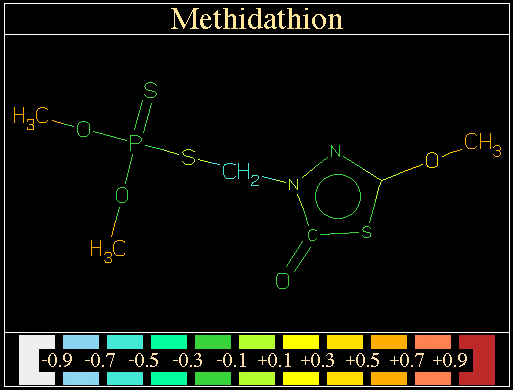
dt_clogp4() returns all results as molecular properties. Basic results are returned in the molecular properties "cp4ver" (dt_String-valued version), "cp4err" (dt_Integer-valued error level) and "cp4val" (dt_Real-valued result). These are obtained in the normal toolkit manner, e.g.:
dt_String version;
dt_Integer errlev, lenver, request = 0;
dt_Real value;
...
errlev = dt_clogp4(fdb, mol, request);
...
value = dt_real ( mol, 6, "cp4val");
errlev = dt_integer( mol, 6, "cp4err");
version = dt_string (&lenver, mol, 6, "cp4ver");
...
printf("clogp4, ver %.*s: result %.3f, error level %d\n",
lenver, version, value, errlev);
|
This interface is not much cleaner (representation-independent) than a conventional toolkit interface would be (e.g., separate dt_clogp_value(), dt_clogp_errlev(), dt_clogp_version() functions).
So what's the big deal?
The answer is that the same set of base functions may be used for communication of more sophisticated information. Furthermore, such communication can be done in a perfectly compatible manner. For instance, CLOGP3 writes a number of ASCII tables when given the appropriate request, e.g.,
+----------+------+----------------------------------------+----------+-------+ | Class | Type | Log(P) Contribution Description | Comment | Value | +----------+------+----------------------------------------+----------+-------+ |FRAGMENT | # 1 | Phosphonate |MEASURED | -2.670| |FRAGMENT | # 2 | Carbonyl |MEASURED | -1.840| |ISOLATING |CARBON| 4 Aliphatic isolating carbon(s) | | 0.780| |EXFRAGMENT|HYDROG| 11 Hydrogen(s) on isolating carbons | | 2.497| |EXFRAGMENT|BONDS | 4 chain and 0 alicyclic (net) | | -0.480| |FRAGBRANCH|FRAG 1| 3 net bonds (out of 4) count. | | -0.570| |PROXIMITY |Y-C-Y | Frags 1 and 2: -.32 (-2.670+ -1.840)| | 1.443| +----------+------+----------------------------------------+----------+-------+ |RESULT | v355 |All fragments measured |CLOGP355 | -0.840| +----------+------+----------------------------------------+----------+-------+ |
Using object properties to detach computation from output, clogp4 "output" can be easily used to deliver simple modern tables (e.g., for HTML):
...
errlev = dt_clogp4(fdb, mol, CP4_REQ_TABLE2);
...
/*** Write Table 2 as an HTML table. ***/
if (NULL_OB != (table = dt_handle(mol, 7, "cp4tab2"))) {
printf("<TABLE BORDER>\n");
/*** Write title ("title" property of table) if available. ***/
str = dt_string(&lens, table, 5, "title");
if (str && lens) printf("<CAPTION>%.*s<CAPTION>\n", lens, str);
/*** Table is a sequence of rows; rows are a sequence of cells. ***/
while (row = 0; NULL_OB != (tabline = dt_next(table)); row++) {
printf("<TR>\n");
while (NULL_OB != (tabcell = dt_next(tabline))) {
str = dt_stringvalue(lens, tabcell);
if (NULL == str || 0 == lens) { str = " "; lens = 6; }
printf("<%s>%.*s\n", (row ? "TD" : "TH"), lens, str);
}
}
printf("</TABLE>\n");
}
|
Alternatively, utility functions can be used to write tables which are customized for lineprinter, PostScript, tab-delimited format, HTML, etc. For instance, sosos2htmltab() produces:
| Class | Type | Log(P) Contribution Description | Comment | Value |
|---|---|---|---|---|
| Fragment | # 1 | Phosphonate | MEASURED | -2.670 |
| Fragment | # 2 | Carbonyl | MEASURED | -1.840 |
| Isolating | carbon | 4 Aliphatic isolating carbon(s) | 0.780 | |
| Exfragment | hydrogen | 11 Hydrogen(s) on isolating carbons | 2.497 | |
| Exfragment | bonds | 4 chain and 0 alicyclic (net) | -0.480 | |
| Fragbranch | fragment 1 | 3 net bonds (out of 4) count. | -0.570 | |
| Proximity | Y-C-Y | Frags 1 and 2: -.32 (-2.670+ -1.840) | 1.443 | |
| RESULT | v355 | All fragments measured | CLOGP355 | -0.840 |
So far we've just been doing what CLOGP3 already does, albeit in a more object-oriented manner. The real power of using object properties is that we can add functionality to computations without adding complexity to the computational API. For example, clogp4 optionally provides atomic contributions to computed hydrophobicity (aside: this is not the same idea as atomic hydrophobicity). Instead of inventing a new API call which returns the atomic values in a canonically ordered array (or some such scheme), atomic values are simply returned as the "cp4val" property of atoms. Here's an example of how they might be used:
...
errlev = dt_clogp4(fdb, mol, CP4_REQ_ATOMS);
...
printf("clogp4 results:\n");
version = dt_string (&lenver, mol, 6, "cp4ver");
printf(" clogp4 version ... %.*s\n", lenver, version);
printf(" error level ...... %.3f\n", dt_integer(mol, 6, "cp4err"));
printf(" molecular value .. %d\n", dt_real(mol, 6, "cp4val"));
printf(" atomic values:\n");
atoms = dt_stream(mol, TYP_ATOM);
while (i = 0; NULL_OB != (atom = dt_next(atoms)); i++)
printf(" atom %3d: value %.3f\n", i+1, dt_real(atom, 6, "cp4val"));
dt_dealloc(atoms);
|

| Class | Type | Log(P) Contribution Description | Comment | Value
| Fragment
| # 1
| ether
| measured
| -0.610
| Fragment
| # 2
| thiadiaza-2-one
| approximate
| -0.430
| Fragment
| # 3
| thiophosporothioate
| approximate
| 0.300
| Isolating
| carbon
| 4 aliphatic isolating carbon(s)
|
| 0.780
| Isolating
| carbon
| 1 aromatic isolating carbon(s)
|
| 0.130
| Exfragment
| hydrogen
| 11 hydrogen(s) on isolating carbons
|
| 2.497
| Exfragment
| bonds
| 4 chain and 0 alicyclic (net)
|
| -0.480
| Fragbranch
| fragment 3
| 3 net bonds (out of 4) count
|
| -0.270
| Proximity
| Y-C-Y
| fragments 2 and 3: -.32 (-0.430+ 0.300)
|
| 0.042
| Electronic
| sigma-rho
| 1 potential interaction(s); 1.00 used
| within ring
| 0.450
| Result
| v4.01
| benzyl approximation used
| clogp401
| 2.409
| LogPstar
| logpstar97
| EPA-600/2-81-011
|
| 2.420
| Residual
| v4.01
| observed - calculated
|
| +0.011
| |
|---|